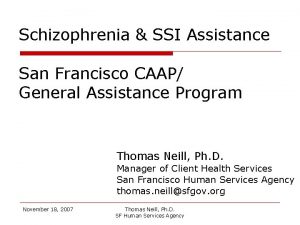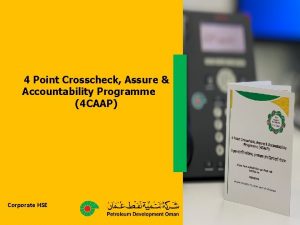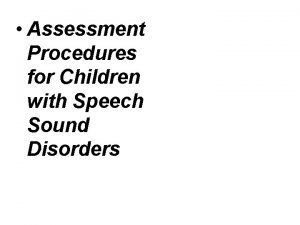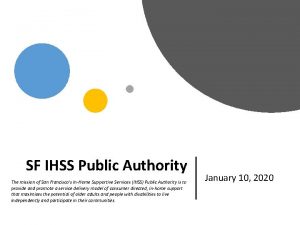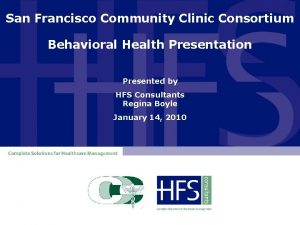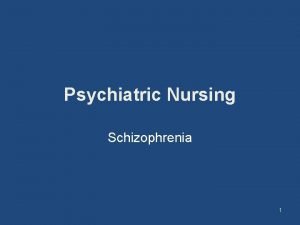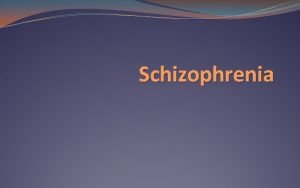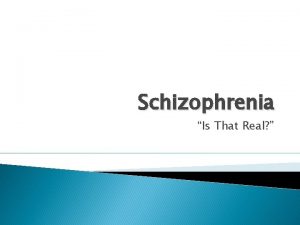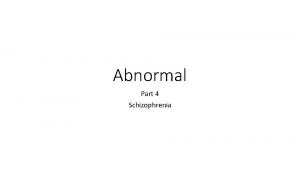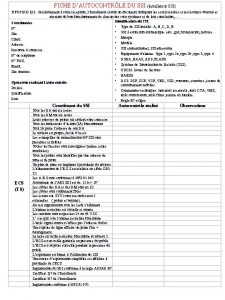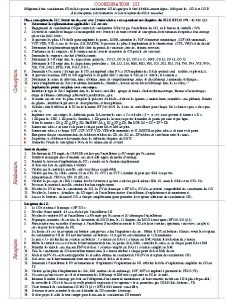Schizophrenia SSI Assistance San Francisco CAAP General Assistance

















- Slides: 17

Schizophrenia & SSI Assistance San Francisco CAAP/ General Assistance Program Thomas Neill, Ph. D. Manager of Client Health Services San Francisco Human Services Agency thomas. neill@sfgov. org November 18, 2007 Thomas Neill, Ph. D. SF Human Services Agency

Introduction HSA Provides material support for individuals and families that includes programs such as Cal. WORKs, Food Stamps, Adult Protective Services, and Foster Care. I develop and manage health services for a program that is part of the San Francisco Human Services Agency (HSA) November 18, 2007 Thomas Neill, Ph. D. SF Human Services Agency 2

Key Points There is a significant population of individuals with schizophrenia who are not engaged in treatment. These individuals generally live marginally with inadequate housing and health care and cope with chronic co-occuring illnesses. I want to describe our efforts to engage these individuals and improve their quality of lives. November 18, 2007 Thomas Neill, Ph. D. SF Human Services Agency 3

General Assistance or County Adult Assistance Programs (CAAP) Need based financial support for those with no other means of support Fulfils state mandate, locally funded and controlled Adults without dependent children Welfare reform in 1998 added services Welfare to work Assistance with SSI/SSDI applications November 18, 2007 Thomas Neill, Ph. D. SF Human Services Agency 4

Characteristics of the Setting Large population Non-clinical setting Current enrolment: 7, 300 Annual unduplicated: 12, 500 Clients come for financial support Health needs of population largely unknown Opportunity to engage clients who would not otherwise seek health services November 18, 2007 Thomas Neill, Ph. D. SF Human Services Agency 5

Client Characteristics Long-standing functional impairments in both vocational & social arenas Aging population: 42% 50+yrs; 70% 40+yrs Untreated medical, dental and behavioural health conditions Over-reliance on emergency services; Clients lack ongoing care & critical medical evidence Limited ability to describe difficulties Provide incoherent accounts of history of illnesses and treatment November 18, 2007 Thomas Neill, Ph. D. SF Human Services Agency 6

Clients with Schizophrenia on CAAP No accurate data on prevalence in the welfare population Anecdotal information shows that many clients have prominent delusional thinking. Clients with unrealistic employment goals or prominent paranoia in welfare to work program Psychosis identified in work readiness screening and SSI case management November 18, 2007 Thomas Neill, Ph. D. SF Human Services Agency 7

Stigma Limits Engagement Common presentation, clients with prominent delusions and no insight Denial preserves self-esteem SSI and Disability – Interpreted as an indication of defect and lack of worth Overcoming stigma of SSI/Disability Empathize with delusional thoughts Engage with intermediary goals – improve quality of life Support clients' vocational aspirations November 18, 2007 Thomas Neill, Ph. D. SF Human Services Agency 8

CAAP SSI Case Management Goal: Identify clients with disabilities and assist them through the SSA application process Staffing Model Clinicians screen for disability and provide medical evidence Case managers complete application material and research histories Outreach workers bring clients to missed appointments November 18, 2007 Thomas Neill, Ph. D. SF Human Services Agency 9

Scale of Program Average Available Staff FY 0809 Case Managers 12. 5 FTE Physicians 2. 3 FTE Psychologists 2. 6 FTE FY 0809 Transitioned to SSI/SSDI/CAPI 504 Clients Current: 1, 817 Clients identified as possibly eligible for SSA Disability Benefits November 18, 2007 Thomas Neill, Ph. D. SF Human Services Agency 10

Sample Client 1 (Applied 2008) Age 61 Af. Am woman, formerly homeless Prominent paranoid and grandiose delusions, disorganized speech Conflict with others in SRO No known treatment history; Limited primary care Fired first CM and Ph. D in CAAP SSI CM Behavior directed by delusions Challenge to engage Awarded thru use of collateral data Housing provider & limited medical records November 18, 2007 Thomas Neill, Ph. D. SF Human Services Agency 11

Sample Client 2, (Applied 2007) Age 46, male, SF native, lives w/ family friends Symptoms: flat affect, command hallucinations, paranoia, uncomfortable around others Missed appointments Behavioural problems in school, no records Father gave him beer age 8, onset of regular alcohol and stimulants in adolescence Substance use treatment age 30 -36 Currently drinks 4 beers/day, denied stimulants November 18, 2007 Thomas Neill, Ph. D. SF Human Services Agency 12

Sample Client 2, Slide 2 (Applied 2007) Psychiatric treatment 6 psychiatric ER visits in last 10 yrs BIB police, threatening others Psychotic symptoms, sometime with and sometimes without stimulant use Began outpatient treatment in 2007 Initial claim denied finding that he would be more functional without current alcohol use. Awarded on appeal with documented continued symptoms in absence of stimulant use November 18, 2007 Thomas Neill, Ph. D. SF Human Services Agency 13

Keys to Success - Network Onsite to be close to clients Stay Connected to Clients Community Treatment Providers Non-clinical staff who work with our clients: CAAP eligibility workers, housing providers & support services, shelter case manager's, etc. Outreach workers Hold CAAP Benefits November 18, 2007 Thomas Neill, Ph. D. SF Human Services Agency 14

Key Community Partners SSA District Office State Department of Social Services Exchange information Manage flow of claims Developing closer relationship with Disability Determination Section Department of Health Provides access to Electronic Medical Records to Research Treatment Histories Coordinate programs for this clientele November 18, 2007 Thomas Neill, Ph. D. SF Human Services Agency 15

Challenges to Show Disability Co-occurring substance use Alcohol & opioids do not cause psychosis Request that DDS reevaluate co-occuring alcohol or opioid use as reason for denial of claim Limited treatment history cited as reason for denial despite consultative exam documenting signs and symptoms of schizophrenia Economic & legal challenges for clients whose symptoms lead them to homelessness and avoidance of needed care November 18, 2007 Thomas Neill, Ph. D. SF Human Services Agency 16

Challenges to Stability Maintaining Housing - Need for increased money management Psychotic symptoms often lead to homelessness and further deterioration Need help from SSA Require money management for clients with risk of homelessness Reconsider funding for money management programs – possible partnerships with HSA & DPH November 18, 2007 Thomas Neill, Ph. D. SF Human Services Agency 17
 General assistance in san francisco
General assistance in san francisco Msei usfca
Msei usfca 4 caap
4 caap Caap articulation test
Caap articulation test Escaleras de san francisco
Escaleras de san francisco San francisco ihss public authority
San francisco ihss public authority Lgst 100 upenn
Lgst 100 upenn San francisco de sales para colorear
San francisco de sales para colorear El padre coll
El padre coll Francisco coll morales
Francisco coll morales Qcon san francisco
Qcon san francisco Museum of modern art san francisco
Museum of modern art san francisco Colegio san francisco de asis temuco
Colegio san francisco de asis temuco Colegio san francisco de asis temuco
Colegio san francisco de asis temuco 1988 earthquake san francisco
1988 earthquake san francisco Ryan furtado
Ryan furtado Lina mara
Lina mara San francisco community clinic consortium
San francisco community clinic consortium
